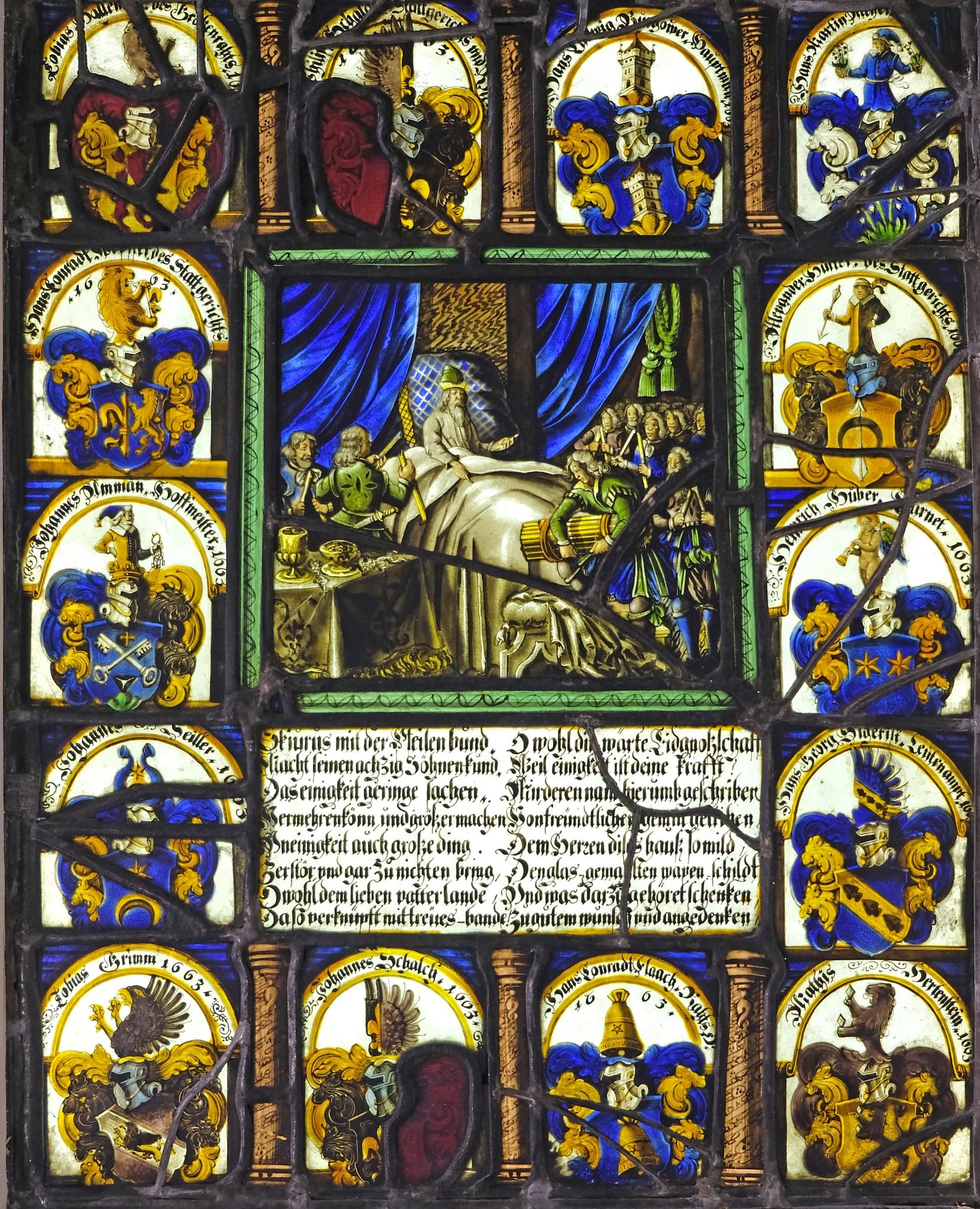Representing members in a government association, the panel depicts the parable of the Old Man and his Sons, also called The Bundle of Sticks, traced back to Aesop’s Fables. The rectangular scene sits above a long inscription. In the center, a king on his death bed is silhouetted against deep blue curtains. His many sons crowd on either side of the bed, each holding a single or bound group of sticks. The king demonstrates that bound sticks cannot be broken, but breaking a single stick is an easy task. Thus, he instructs them on the value of solidarity, The scene is framed by the members’ heraldic shields, two shields above and below and five shields to the left and to the right.
46A122(BURGOWER) · Wappenschild, heraldisches Symbol (BURGOWER)
46A122(GRIMM) · Wappenschild, heraldisches Symbol (GRIMM)
46A122(HALLEN) · Wappenschild, heraldisches Symbol (HALLEN)
46A122(HERTENSTEIN) · Wappenschild, heraldisches Symbol (HERTENSTEIN)
46A122(HUBER) · Wappenschild, heraldisches Symbol (HUBER)
46A122(HUTTER) · Wappenschild, heraldisches Symbol (HUTTER)
46A122(MEYER) · Wappenschild, heraldisches Symbol (MEYER)
46A122(SCHALCH) · Wappenschild, heraldisches Symbol (SCHALCH)
46A122(SEILER) · Wappenschild, heraldisches Symbol (SEILER)
46A122(SIGRIST) · Wappenschild, heraldisches Symbol (SIGRIST)
85A(THE OLD MAN AND HIS SON) · Fabeln des Aesop (THE OLD MAN AND HIS SON): 85 (...) benutzen
98B(SCYLURUS)68 · der Tod des Scylurus: auf seinem Sterbebett fordert der Scythenkönig seine achtzig Söhne auf, ein Bündel von Stöcken (oder Pfeilen) zu zerbrechen; als sie dazu nicht in der Lage sind, zerbricht er die Stöcke einzeln, um den Söhnen beizubringen, daß sie vereint stark, getrennt aber schwach seien
All with crested helms; 1. or a lion rampant; 2. azure a fleur-de-lis or, impaled by azure a lion rampant or, 3. azure two crossed keys or, per base three hills vert with triangle argent, per chief a cross or, 4. azure a crescent and a mullet or, 5. argent a bend argent with a raven rampant sable and or thereon, 6. or impaled gules, a lure sable, 7. azure a bell inscribed with a mullet or, 8. or a lion rampant sable holding two diamonds argent, 9. azure a bend or with three spades sable thereon, 10. azure two mullets or, 11. or a crescent sable over an arrow argent, 12. azure sprays with leaves vert and blossoms argent, 13. azure a tower argent supported by three hills or, 14. gules impaled or a lure sable
1. Tobias Hallen des Grossenrahts 16[ . . ]; 2. Hans Conrad [ . . ] Stattgerichts 1663; 3. Johannes Amman Hoffmeister 1663; 4.·Johannes Seiller 1663; 5.·Tobias Grimm 1663; 6. Johannes Schalch 1663; 7. Hans Conradt Flaach Rahts 1663; 8. Mathis Hertenstein 166 3; 9. Hans Georg Sigerist Leutenenampt 1663; 10. Heinrich Huber [ . . ]arnet 1663; 11. Alexander Hutter des Stattgerichts 1663; 12. Hans Martin Meyer; 13. Hans Ludwig Burgower Hauptman 1663; 14. Philip Schal[ . . ] Stattgerichts und [ . . ] 1663
Skiurus mit der Pfeilen bund/ Macht seinen achzig Sohnenkund/ Das einigkeit geringe sachen/ Vermehren könn und grosser machen/ Unkeinigkeit auch grosse ding/Zerstör und gar zu nichten bring/ O wohl dem lieben vatterlande/ Dass verknüpft mit treues bande !/ O wohl d[ .] wärte Eidgnossschaft/ Weil einigke[ .]t ist deine krafft/ Kinderen nam hierumb geschriben/ Von freudtlichen gemut ge[ . . ]hen/ Dem Herzen dis[ .]s hauss so mild/ Den glasgemalten wapen schildt/ Und was darzu gehoret schenken/ Zu guten wunsch und angedenken /
(Skiurus with his bound shafts/Makes it known to his eighty sons/ That unity can increase and make greater, lesser things. / Disunity [can] also destroy greater things/ and even bring them to naught./ Health to the dear fatherland,/ that makes the tie with loyalty’s bond!/ Health to the awaited fraternity [Confederation]/ because unity is your strength!/ By those children whose names are inscribed around it,/ to whom a friendly spirit has been given,/ to the heart of this house, so kind, and all that belongs to it,/ this shield of painted glass is given/ as an expression of good wishes and pleasant memories.)
none
